
The Belgian Coal Mining Industry

Eisden Coal Mines
A Relic of the Past
My short stay in Eisden in July 2002, with its strong association with my late aunt and her vivid stories, meant I could not miss the opportunity to investigate the site of the old coal mines. The Belgian coal mining industry in Flanders
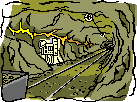 seems to have developed rapidly from 1901 onwards, with coal mines located in Beringen, Zolder, Houthalen, Zwartberg, Winterslag and Waterschei as well as in Eisden. Because the rural areas were thinly populated, many labourers were brought in initially from Eastern-European countries to work in the new mines. However, during the period immediately after World War II, the mine workers in the Maasmechelen province came predominantly from Italy - many settling permanently in and around Eisden.
seems to have developed rapidly from 1901 onwards, with coal mines located in Beringen, Zolder, Houthalen, Zwartberg, Winterslag and Waterschei as well as in Eisden. Because the rural areas were thinly populated, many labourers were brought in initially from Eastern-European countries to work in the new mines. However, during the period immediately after World War II, the mine workers in the Maasmechelen province came predominantly from Italy - many settling permanently in and around Eisden.
Throughout the period of occupation by Nazi Germany during the Second World War,
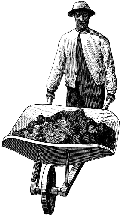 (as my aunt tells us in her story about the four Russian Officers), the labour force for the Eisden Mines consisted mainly of Russian Prisoners of War. The tables were turned after the German forces capitulated, when the Russians were replaced by German Prisoners of War. The nearby Prisoner of War camp where, first the Russians and then the Germans were imprisoned,(and which later served as temporary accommodation for the Italian workers), was demolished some years ago and is now a football field. The Eisden coal mine itself was closed down in 1987, when there was a general slump in coal production from the Limburg mines. As a result, unemployment figures in the Maasmechelen area rose dramatically.
(as my aunt tells us in her story about the four Russian Officers), the labour force for the Eisden Mines consisted mainly of Russian Prisoners of War. The tables were turned after the German forces capitulated, when the Russians were replaced by German Prisoners of War. The nearby Prisoner of War camp where, first the Russians and then the Germans were imprisoned,(and which later served as temporary accommodation for the Italian workers), was demolished some years ago and is now a football field. The Eisden coal mine itself was closed down in 1987, when there was a general slump in coal production from the Limburg mines. As a result, unemployment figures in the Maasmechelen area rose dramatically.
Today, the economy is reviving and a number of projects are being developed in the region with the help of the Flemish Government. Sadly, what remains of the Eisden coal mines is rapidly disappearing now that a shopping mall, with its own cinema and restaurants, is being developed on the site. Some buildings, including the old Infirmary, have already gone and it is likely that the remaining structures will eventually be demolished and an important part of the history of the area will have disappeared for ever.
I was completely fascinated by the old headframes. They stand well behind some of the new buildings and, if at all possible, I hope that the developers of the site will agree to local pressure that they be incorporated in the plans for any future extensions to the new complex and preserved as part of the heritage and history of the area.
Here are some of my pictures:
The Two Main Towers
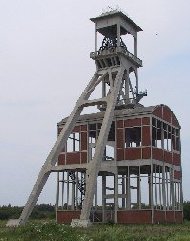
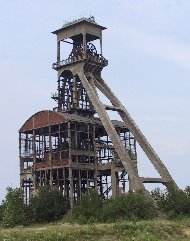
Click here for larger picture (49KB) Click here for larger picture (56KB) These two towers or headframes, which would have supported the pulleys for the winding mechanism at the top of the mineshaft, stand a little way from each other and dominate the northern skyline as you approach from the Kolenmijn Limburg Maaslaan road. The western tower, pictured on the left, is the more modern of the two ruins and gave the impression of an empty cast off shell. The eastern tower is an imposing, stark, rusty skeleton
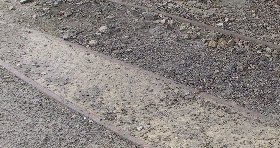
Click here for larger picture (115KB)
of its former self and, to me, was the more fascinating of the two. I was able to walk inside and I could see faint tracks in the dusty earth where I could imagine coal trucks had once rolled by. Incidentally, my Cousin, Michel, told me there is or was a third tower some distance away.
I walked around the older eastern tower, now overgrown with vegetation,
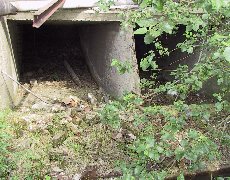
Click here for larger picture (114KB)
and found a small concrete 'pit' filled with water and two 'shafts' beyond it. They were full of bricks and broken masonry. I could see what looked like a bent, long handled shovel-like tool leaning against the wall – probably just a piece of broken piping! What had been the purpose of these shafts? Were they for ventilation? Could they have housed the pulleys underneath the headframe for lowering and lifting a cage for the coalface workers? Or was it a double drum hoist for winding up and lowering coal skips? Perhaps someone can tell me?
Detail West Side of Eastern Tower
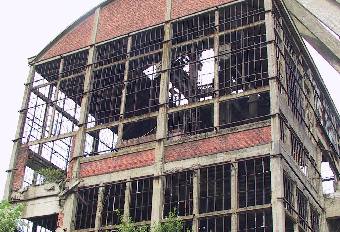
Views of the Headgear
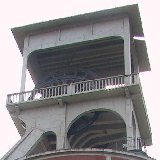
Side View Western Tower |
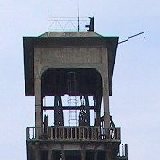
Front View Eastern Tower |
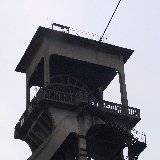
Side View Eastern Tower |
If you came here from Tribute Page One, click HERE to return
Links to Some of My Pages
|
|
|

|
|

|
Copyright © 2002-2005 Tessa Steer (Leyder) / Van Hecke Family - All Rights Reserved Worldwide
|


